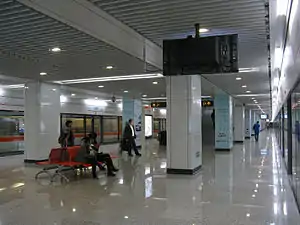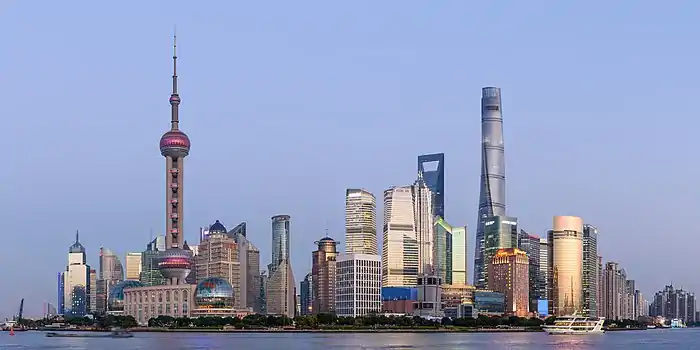Shanghai Metro
The Shanghai Metro (Chinese: 上海地铁) is a rapid transit system in Shanghai, operating urban and suburban transit services to 14 of its 16 municipal districts[note 4] and to Huaqiao Town, Kunshan, Jiangsu Province. Opening in 1993 with full-scale construction extending back to 1986, the Shanghai Metro is the third-oldest rapid transit system in mainland China, after the Beijing Subway and the Tianjin Metro. It has seen substantial growth, significantly during the years leading up to the Expo 2010, and is still expanding quickly, with its most recent expansions having opened in January 2021. It is the biggest component of the Shanghai metropolitan rail transit network, together with the Shanghai maglev train, the Zhangjiang Tram, the Songjiang Tram and the China Railway-operated commuter rail services to Jinshan. The metro system is also integrated with other forms of public transport in Shanghai.
 | |||
 | |||
| Overview | |||
|---|---|---|---|
| Owner | Shanghai Municipal Government | ||
| Locale | Shanghai and Kunshan, Jiangsu | ||
| Transit type | Rapid transit | ||
| Number of lines | 18[note 1] | ||
| Number of stations | 381[note 2] | ||
| Daily ridership | 10.63 million (2019 avg.)[1] 13.29 million (record)[2] | ||
| Annual ridership | 3.880 billion (2019)[1] | ||
| Website | www | ||
| Operation | |||
| Began operation | 28 May 1993 | ||
| Operator(s) | Shanghai Shentong Metro Group China Railway Shanghai Group | ||
| Number of vehicles | 7,000+ revenue railcars[3] | ||
| Technical | |||
| System length | 743 km (461.7 mi)[4][note 3] | ||
| Track gauge | 1,435 mm (4 ft 8 1⁄2 in) standard gauge | ||
| Electrification | DC 1500 V overhead line; DC 1500 V third-rail (Line 16)(Line 17)(Pujiang line) | ||
| |||
| Shanghai Metro | |||||||||||||||
|---|---|---|---|---|---|---|---|---|---|---|---|---|---|---|---|
| Simplified Chinese | 上海轨道交通 | ||||||||||||||
| Traditional Chinese | 上海軌道交通 | ||||||||||||||
| Literal meaning | Shanghai Rail Transit | ||||||||||||||
| |||||||||||||||
| Commonly abbreviated as | |||||||||||||||
| Simplified Chinese | 上海地铁 | ||||||||||||||
| Traditional Chinese | 上海地鐵 | ||||||||||||||
| Literal meaning | Shanghai Subway | ||||||||||||||
| |||||||||||||||
The Shanghai Metro system is the world's biggest metro system by route length, totaling 743 kilometres (462 mi).[5][note 3] It is also the second biggest by the number of stations with 381 stations on 18 lines.[note 1][note 2] It ranks second in the world by annual ridership with 3.88 billion rides delivered in 2019.[1] The daily ridership record was set at 13.29 million on March 8, 2019.[2] Over 10 million people use the system on an average workday.[6]
On 16 October 2013, with the extension of Line 11 into Kunshan in Jiangsu province, Shanghai Metro became the first rapid transit system in China to provide cross-provincial service and the second intercity metro after the Guangfo Metro. Further plans to connect the Shanghai Metro with the metro system of Suzhou are under active review,[7] with the first line connecting Shanghai Metro Line 11 and Suzhou Metro Line 3 under construction and projected to be completed by 2024.[8] Ambitious expansion plans call for 25 lines with over 1,000 km (620 mi) of length by 2025.[9] By then, every location in the central area of Shanghai will be within 600 m (2,000 ft) of a subway station.[10]
History

- May 28, 1993 – Southern section of Line 1 (Shanghai South Railway Station – Xujiahui) enters operation[11][12] (4.4 km or 2.7 mi).
- April 10, 1995 – Line 1 (Jinjiang Park – Shanghai Railway Station; including initial section, which opened 1993) enters operation [11][12] (16.1 km or 10.0 mi).
- December 28, 1996 – Southern extension to Line 1 (Xinzhuang – Jinjiang Park) enters operation (4.5 km or 2.8 mi).[13][14]
- September 20, 1999 – Line 2 (Zhongshan Park – Longyang Road) enters operation (16.3 km or 10.1 mi).[15][16][11]
- December 27, 2000 – The eastern extension to Line 2 (Longyang Road – Zhangjiang Hi-Tech Park) (2.8 km or 1.7 mi)[17][11] and Line 3 (Shanghai South Railway Station – Jiangwan Town) (24.6 km or 15.3 mi)[11][17] open.
- November 25, 2003 – Line 5 (Xinzhuang – Minhang Development Zone) enters operation (17.2 km or 10.7 mi).[18]
- December 28, 2004 – Northern extension to Line 1 (Shanghai Railway Station – Gongfu Xincun) enters operation (12.4 km or 7.7 mi).[19]
- December 31, 2005 – Line 4 enters operation, except the section between Lancun Road and Damuqiao Road that was delayed due to a construction accident.[20]
- December 18, 2006 – Northern extension to Line 3 (Jiangwan Town – North Jiangyang Road) enters operation (15.7 km or 9.8 mi).[21][11]
- December 30, 2006 – Western extension to Line 2 (Songhong Road – Zhongshan Park) enters operation (6.15 km or 3.82 mi).[11][21]
- December 29, 2007 – Five lines or sections enter operation on the same day:[22]
- Second northern extension to Line 1 (Gongfu Xincun – Fujin Road) (3.4 km or 2.1 mi)[23]
- Delayed section of Line 4 (Lancun Road – Damuqiao Road), completing the loop.[23]
- Line 6 (Gangcheng Road – South Lingyan Road) (31.1 km or 19.3 mi)[23]
- Line 8 (Shiguang Road – Yaohua Road)[23]
- Line 9 (Songjiang Xincheng – Guilin Road)[23]
- December 28, 2008 – Line 9 is extended from Guilin Road to Yishan Road, connecting with the rest of the metro network.[24]
- July 5, 2009 – Southern extension to Line 8 (Yaohua Road – Shendu Highway) enters operation (14.4 km or 8.9 mi).[25]
- December 5, 2009 – Line 7 (Shanghai University – Huamu Road) enters operation (34.4 km or 21.4 mi).[25][26]
- December 31, 2009 – The downtown section of Line 9 (Yishan Road – Century Avenue) and[25] the first section of Line 11 (Jiangsu Road – North Jiading)[25] open.
- February 24, 2010 – Short section of eastern extension of Line 2 (Longyang Road – Guanglan Road) enters operation. Zhangjiang Hi-tech Park station is rebuilt underground.[27]
- March 16, 2010 – Second western extension to Line 2 (East Xujing – Songhong Road) enters operation, connecting Hongqiao Airport to the metro system.[11][27]
- March 29, 2010 – Branch line of Line 11 (Jiading Xincheng – Anting) enters operation.
- April 7, 2010 - Middle Yanggao Road opens on line 9.
- April 8, 2010 – Eastern extension to Line 2 (Guanglan Road – Pudong International Airport) enters operation, connecting the two airports.[27][28]
- April 10, 2010 – Line 10 (Xinjiangwancheng – Hangzhong Road) enters operation.[27] Shanghai Metro becomes the longest metro system in the world after 15 years of breakneck growth.[29]
- April 20, 2010 – Expo section of Line 13 (Madang Road – Shibo Avenue) enters temporary operation.[30][31]
- July 1, 2010 – with the opening of Hongqiao railway station, its metro station of the same name on Line 2 enters operation.
- November 2, 2010 – With the end of the Shanghai Expo, the Expo section of Line 13 suspends service, to be reopened when the rest of the line is completed.
- November 30, 2010 – Section of Line 10 (Longxi Road – Hongqiao Railway Station) enters operation, connecting the two terminals of Hongqiao Airport.[27]
- December 28, 2010 – The 10-km long northern extension to Line 7 (Shanghai University – Meilan Lake) enters operation.[27]
- April 12, 2011 – Oriental Sports Center station opens[32][33]
- April 26, 2011 – Line 11 East Changji Road station opens.[32]
- June 30, 2011 – Panguang Road and Liuhang Stations on Line 7 open.[32]
- September 28, 2012 – China Art Museum station on Line 8 opens.
- December 30, 2012 – The southern extension of Line 9 (Songjiang South Railway Station – Songjiang Xincheng) opens[34] and the first phase of Line 13 (Jinyun Road – Jinshajiang Road) opens as well.[34]
- June 15, 2013 – South Qilianshan Road station on Line 13 opens.
- August 31, 2013 – The second phase of Line 11 (Jiangsu Road – Luoshan Road) enters operation.[35]
- October 16, 2013 – The 6-km long branch extension of Line 11 (Anting – Huaqiao) enters operation. Shanghai Metro is extended into Jiangsu province,[36] and becomes the first inter-provincial Chinese rapid transit system and second intercity system.
- December 29, 2013 – The eastern section of Line 12 (Tiantong Road – Jinhai Road) and Line 16 (Luoshan Road – Dishui Lake) both enter operation.[37]
- May 10, 2014 – Line 12 Extension to Qufu Road station.[38]
- July 22, 2014 – Qihua Road station on Line 7 opens.
- November 1, 2014 – Daduhe Road station on Line 13 opens.
- December 28, 2014 – Extensions to Line 13 (Jinshajiang Road – Changshou Road) and Line 16 (Luoshan Road – Longyang Road) open [39]
- December 19, 2015 – Extensions to Line 11 (Luoshan Road – Kangxin Highway), Line 12 (Qufu Road – Qixin Road), Line 13 (Changshou Road – Shibo Avenue) open.[40]
- April 26, 2016 – Disney Resort station on Line 11 opens.[41]
- December 30, 2017 – Line 17 opens from Hongqiao Railway Station to Oriental Land along with eastern extension of Line 9 from Middle Yanggao Road to Caolu.[42]
- March 31, 2018 – Pujiang line (Shendu Highway – Huizhen Road) enters operation.[43]
- December 30, 2018 – Extensions to Line 5 (Dongchuan Road – Fengxian Xincheng) and Line 13 (Shibo Avenue – Zhangjiang Road) open.[44]
- August 25, 2020 – Chenxiang Highway station on Line 11 opens.[45]
- December 26, 2020 – Extensions to Line 10 (Guofan Road – Jilong Road) and Line 18 (Yuqiao – Hangtou) opens.[5]
- January 23, 2021 – Line 15 enters operation, except Guilin Road station.[4]
Lines
There are currently 16 lines in operation, with Lines and services are denoted numerically as well as by characteristic colors, which are used as a visual aid for better distinction on station signage and on the exterior of trains, in the form of a colored block or belt.
Most tracks in the Shanghai Metro system are served by a single service; thus "Line X" usually refers both to the physical line and its service. The only exception is the segment shared by Lines 3 and 4, between Hongqiao Road station and Baoshan Road station, where both services use the same tracks and platforms.

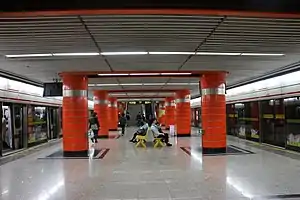 Xinzha Road station of Line 1
Xinzha Road station of Line 1.jpg.webp) Yuandong Avenue station of Line 2
Yuandong Avenue station of Line 2 Dongbaoxing Road station of Line 3
Dongbaoxing Road station of Line 3 Pudong Avenue station of Line 4
Pudong Avenue station of Line 4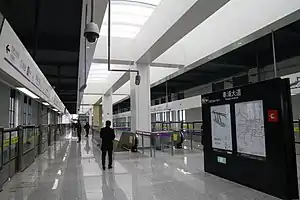 Fengpu Avenue station of Line 5
Fengpu Avenue station of Line 5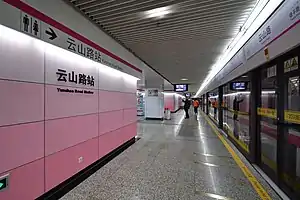 Yunshan Road station of Line 6
Yunshan Road station of Line 6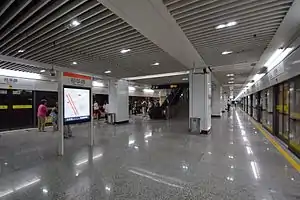 Qihua Road station of Line 7
Qihua Road station of Line 7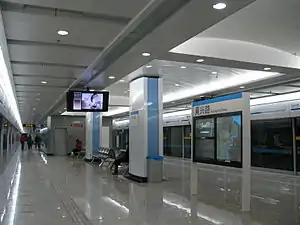 Huangxing Road station of Line 8
Huangxing Road station of Line 8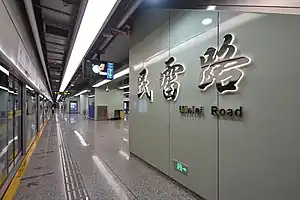 Minlei Road station of Line 9
Minlei Road station of Line 9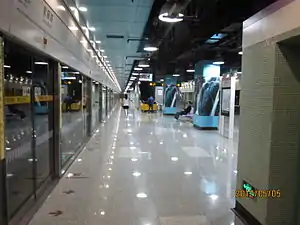 Ziteng Road station of Line 10
Ziteng Road station of Line 10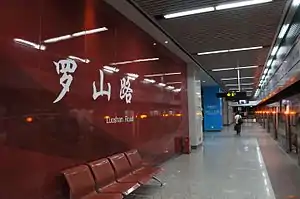 Luoshan Road station of Line 11
Luoshan Road station of Line 11 Donglu Road station of Line 12
Donglu Road station of Line 12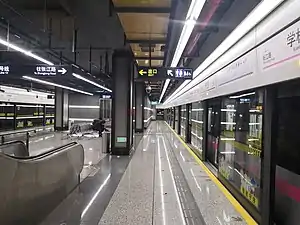 Xuelin Road station of Line 13
Xuelin Road station of Line 13 Dishui Lake station of Line 16
Dishui Lake station of Line 16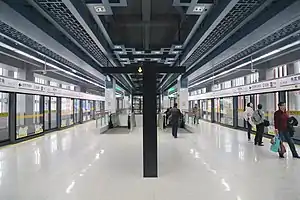 Zhujiajiao station of Line 17
Zhujiajiao station of Line 17 Minrui Road station of Pujiang Line
Minrui Road station of Pujiang Line
Services
Partial service patterns
Partial service patterns exist on Lines 1, 2, 3, 6, 7, 8, 9, 11, 12 and 17.[46][56][47][49][50][51][57][52][53] Partial services serve only a (usually busier) sub-segment of the entire physical line. In addition, Line 2 had a piecewise service pattern during morning peak hours whereby the suburban segment between Guanglan Road station and Pudong International Airport station is partially served by a 4-car fleet in addition to the regular 8-car fleet serving the whole line before April 19, 2019.
Since 28 December 2018, during off-peak times, an 8-car fleet from East Xujing or Songhong Road station may terminate at Pudong International Airport station, but most trains still terminate at Guanglan Road station or Tangzhen (only during peak hours). 8-car train started serving the whole line in a regular schedule from April 19, 2019.[58]
Partial services make it easier to find seats on the metro in rush hours. As an example, every second east-bound train on line 12 passing Caobao Road station is much more empty because it departed from Hongmei Road station.
Line 12 has a partial service between Hongmei Road and Jufeng Road.
Line 11, one of the three branch lines of the metro system, operates a different partial service pattern. Trains travelling to and from the branch line terminate at Huaqiao Station and Sanlin respectively. Hence, a passenger who wants to travel from the terminus of the branch to the eastern terminus of the line, at Disney Resort must change trains.[52]
Line 17, which opened in December 2017, operates a partial service pattern from Hongqiao Railway Station to Dianshanhu Avenue during rush hours in addition to the full service to Oriental Land.[59]
Line 16
Line 16, unlike the rest of the system, is built with passing loops and operates a rush-hour express service. The service was postponed on January 30, 2014, due to lack of available trains, but resumed on March 21, 2016.[60][61][62]
Announcements
All trains in the Shanghai Metro display destinations in Simplified Chinese and English, and make announcements in Standard Mandarin, English, and (on line 16 only) Shanghainese in order to indicate next stations, directions, and partial/full-length service patterns.[63]
Operating hours
The operating hours for most Shanghai metro stations starts between 5:00 to 6:00 in the morning and ends between 22:30 to 23:00 CST. In February 2017 (Shanghai Metro) announced that by April 1, 2017, the operating hours of Line 1, 2, and 7 to 10 will be extended by an hour after the regular last train on each Friday, Saturday and last working days before Chinese Public Holidays. This will be extended to Lines 3, 4, 6, and 11 to 13 by July 1, 2017. By the end of 2018, all the stations in the city center will extend their operating hours after midnight. Also, there will be two trains taking passengers from Hongqiao Railway Station after normal operation time and only stop at several stations, which always happens on the last day of a vacation, e.g. Labor Day, National Day, etc.[64]
Stations
Transfer stations
There are two types of transfer stations: physical transfer stations and transit-card only ones. In a physical transfer station, passengers can transfer between subway lines without exiting a fare zone. In a transit-card only transfer station, however, passengers have to exit and re-enter fare zones as they transfer from one subway line to another. In order to receive a discounted fare, passengers must use a Shanghai public transport card (SPTC) instead of Single-Ride tickets.
- Baoshan Road, Shanghai Railway Station, Zhongtan Road, Zhenping Road, Caoyang Road, Jinshajiang Road, Zhongshan Park, West Yan'an Road and Hongqiao Road are interchanges between Lines 3 and 4. This is where the two lines share tracks between Baoshan Road and Hongqiao Road.
- Lines 4 and 6 stop at two different stations both known as Pudian Road, but these two stations are not located together and interchanging is not possible.
- Longyang Road and Pudong International Airport stations also provide transfers to the Shanghai maglev train, though passengers have to make another payment if they board the Maglev train.
Transit-card only transfer stations
A transit-card only transfer station is a station where two lines meet, but unlike a physical interchange, there is no direct pathway between them within the paid fare area. Passengers wishing to interchange must exit the paid fare area for the first line, walk a short distance on the street, and re-enter the paid fare area for the second line. Since June 1, 2008, passengers interchanging using a Shanghai public transport card have their trip regarded as one journey and the distance will be accumulated for fare calculation. Passengers must exit a station and re-enter another within 30 minutes using the same Shanghai public transport card. Those using single-ride tickets cannot use virtual transfers and must purchase a new ticket.
In some cases, virtual interchanges in place during a period of construction were superseded by physical interchanges at the completion of the construction. For example, Hongkou Football Stadium station was previously a virtual interchange between Line 3 and Line 8. Another previously virtual interchange was South Shaanxi Road station between Line 1 and Line 10; after the opening of an extension of line 12 to the station in December 2015 transfers among all three lines became a physical interchange.
The current virtual interchanges are:
- Changqing Road is a virtual interchange station between Line 7 and Line 13.
- Hongqiao Airport Terminal 2 is a virtual interchange station between Line 2 and Line 10. However, Line 2 trains bound for Pudong International Airport and Line 10 trains bound for Xinjiangwancheng share an island platform. The middle island platform of the station opened in January 2018, so that passengers may transfer from downtown Line 2 and Line 10 trains by walking through the middle island platform.
- Shanghai Railway Station is a virtual interchange station between Line 1 and Line 3 / Line 4, but Line 3 and Line 4 share the same platforms and the transfer between Lines 3 and 4 can be made by simply waiting for the next train to arrive at the platform.
- West Nanjing Road is a virtual interchange station among Line 2, Line 12 and Line 13.
- Loushanguan Road is a virtual interchange station between Line 2 and Line 15.
Transport hubs
The busiest station in Shanghai Metro system is People's Square (Lines 1, 2 and 8). As the interchange station for three lines, it is extremely crowded during peak hours. It remains busy during the rest of the day as it is located near major shopping and tourist destinations such as East Nanjing Road, a pedestrian street, as well as the Shanghai Museum, People's Park, the Shanghai Grand Theatre and Yan'an Park on People's Square. It has the second largest number of exits (totalling 17) in the stations of the metro system.
Xujiahui (Lines 1, 9 and 11) is located in the major Xujiahui commercial center of Shanghai. Six large shopping malls and eight large office towers are each within a three-minute walk of one of the station's exits, numbering a total of 18 since the addition of the four in the Line 9 part of the station that opened in December 2009. This is the largest number of exits of all the stations on the system. This station is also widely used as a pedestrian tunnel across the wide roads.
Lujiazui (Line 2) is the major station in Pudong area. It is situated in the heart of Lujiazui financial district, the financial center of Shanghai. The city's iconic landmarks, the Oriental Pearl TV Tower, Jin Mao Tower, Shanghai Tower and Shanghai World Financial Centre are all within walking distance of the station. In contrast to Xujiahui and People's Square, Lujiazui is not particularly busy during off-peak hours or on weekends as it is located in financial district of Shanghai. Line 14, expected to open in 2020, will pass Lujiazui and provide transfer as well.
Shanghai Railway Station (Lines 1, 3 and 4) is a major transportation hub in Shanghai, containing the railway station, two subway lines and the stop for many city bus lines as well as interprovincial buses. These bus lines will soon be housed in a brand-new bus station. The line 1 platform is in the South square while platforms for line 3/4 are in the North square. These two platforms are technically separate stations, so interchange is only possible between lines 3/4. A transfer to the line 1 platform requires a SPTC or a new ticket.
Shanghai South Railway Station (Lines 1 and 3) is a transport station for line 1 and line 3; and the maintenance base of line 1 is also located at Shanghai South Railway Station.
Zhongshan Park (Lines 2, 3 and 4) is a heavily trafficked station due to the large shopping malls and hotel immediately above it.
Century Avenue (Lines 2, 4, 6 and 9) is the largest interchange station in the Shanghai Metro system, and the first station in mainland China to offer an interchange between four metro or subway lines.[65]
Pudong International Airport (Line 2) is the eastern terminus of Line 2. It serves the airport of the same name in Shanghai. The station also provides a transfer with the Shanghai maglev train to Longyang Road.
Hongqiao Railway Station (Lines 2, 10 and 17), Hongqiao Airport Terminal 1 (Line 10) and Hongqiao Airport Terminal 2 (Lines 2 and 10) are metro stations located in the Hongqiao transportation hub, composed of the Shanghai Hongqiao International Airport and Shanghai Hongqiao Railway Station. Both Hongqiao Airport stations are directly linked with the airport, offering many domestic and limited international flights, and the Hongqiao Railway metro station is directly linked with the train station. The airport and railway stations themselves offer a zero-distance transfer.
Ticket system

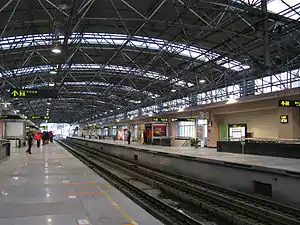
Like many other metro systems in the world (Shanghai Metro) uses a distance-based fare system. The system uses a "one-ticket network", which means that interchanging is possible between all interchange stations, given that the transfer staying within the Shanghai Metro system, without the purchase of another ticket where available, excluding some stations where transferring to another line at said station requires leaving the Fare Zone (i.e. the area extending from the platform to the entry/exit gates) which mandates a Single-Journey Ticket be used before entering that of another line, requiring the purchase of another Single-Journey Ticket (Shanghai Public Transport Cards are exempt as they are not consumed upon exit). The Shanghai Public Transport Card, which allows access to most public transport in Shanghai under one card, is another form of payment.
Fares
- For most lines, the base fare is 3 yuan (RMB) for journeys under 6 km, then 1 yuan for each additional 10 km. As of December 2017, the highest fare is 15 yuan (travel between Oriental Land to Dishui Lake, the farthest distance at present ).
- Shortest route calculated as multiple route available between any entry-exit stations
- Travel time limit is 4 hour. Additional lowest single journey fare (3 yuan) is required if time limit is exceeded.
 Shanghai metro ticketing machine map
Shanghai metro ticketing machine map
| Distance (km) | Fare (yuan) |
|---|---|
| 0-6 | 3 |
| 6-16 | 4 |
| 16-26 | 5 |
| 26-36 | 6 |
| 36-46 | 7 |
| 46-56 | 8 |
| 56-66 | 9 |
| 66-76 | 10 |
| 76-86 | 11 |
| 86-96 | 12 |
| 96-106 | 13 |
| 106-116 | 14 |
| 116-126 | 15 |
- Unlimited ride ticket is available
| Period | Fare (yuan) |
|---|---|
| 1 Day | 18 |
| 3 Day | 45 |
Normal Discounts
- For journeys exclusively on the 1st Phase of Line 5 (Xinzhuang – Minhang Development Zone), the fare is 2 yuan for journeys under 6 km and all other journeys are 3 yuan (though the total length of this section is a bit longer than 16 km). Will not be applied once passengers interchange to other lines, e.g. Fare for passengers from Xinzhuang to Chunshen Road is 2 Yuan, while fare for passengers from Waihuanlu to Chunshen Road is 3 Yuan.
- For journeys exclusively from Xinzhuang Station to People's Square Station, the fare is 4 yuan, though the distance between People's Square Station and Xinzhuang Station is about 17.8 km (11.1 mi).
Discounts for SPTC holders
- Users of the Shanghai public transport card get a 10% discount for the rest of the calendar month after paying 70 yuan in taking metro, e.g. a passenger has paid 67 Yuan on metro tickets through SPTC this calendar month, and next time he will only pay 2.7 yuan for his next 3-yuan ticket in this calendar month. The discount is applied only for journeys after the payment; it is not retroactively applied to previous journeys.
- Users of the Shanghai public transport card as part of the "Air-conditioned Bus Transfer Discount" get a 1 yuan discount when transferring to the metro within 90 minutes. (The 10% monthly discount may be applied after the transfer discount) This discount also applies for a bus to Metro and bus to bus transfers and can accumulate over multiple transfers. For example, to get from Zhenbei Rd/Meichuan Rd to Xiuyan Rd/Hunan Rd would normally cost 8 yuan each way (947 buses to line 4 to 451 bus) but only costs 6 RMB with the card (947 buses discounted transfer to line 4, discounted transfer to 451 bus). Depending on the time spent at the destination the discount will be applied at the start of the return trip as well, making the cost of a round-trip 11 yuan instead of the 16 yuan that would normally be charged without the card.
Single Journey ticket
Single-Journey tickets can be purchased from ticket vending machines, and at some stations, at a ticket window. Single-ride tickets are embedded with RFID contactless chips. When entering the system riders tap the ticket against a scanner above the turnstile, and when they exit they insert the ticket into a slot where it is stored and recycled.
 Line 1 ticket used in 1995-1997
Line 1 ticket used in 1995-1997 Line 1 ticket used in 1997-1999
Line 1 ticket used in 1997-1999 Line 3 ticket used before 2003
Line 3 ticket used before 2003 Line 5 ticket used before 2005
Line 5 ticket used before 2005
Shanghai Public Transportation Card
In addition to a Single-Ride ticket, the fare can be paid using a Shanghai public transport card, which is similar to the Octopus card of Hong Kong's MTR. This RFID-embedded card can be purchased at selected banks, convenience stores and metro stations with a 20-yuan deposit. This card can be loaded at ticket booths, Service Centers at the metro stations as well as many small convenience stores and banks throughout the city. The Shanghai Public Transportation Card can also be used to pay for other forms of transportation, such as taxi or bus.
One-day pass
A one-day pass was introduced for the Expo 2010 held in Shanghai. The fare for the calendar day was set at 18 yuan, for unlimited travel within the metro system. This is not available through vending machines, but has to be purchased at Service Centers at metro stations.[66]
Three-day pass
A three-day pass is available for Shanghai Metro. The fare for three days was set at 45 yuan, for unlimited travel within the metro system. This pass is not available through vending machines, but has to be purchased at Service Centers at metro stations.
Infrastructure
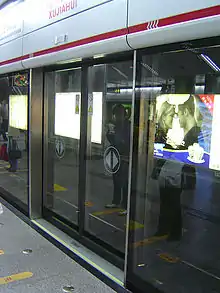

Gauge
Standard gauge is used throughout the network, allowing new train equipment to be transported over the Chinese rail network which uses the same gauge.
Stations
Almost all stations, except most of the elevated sections and sections of Line 2 from Songhong Road to Longyang Road, have platform screen doors with sliding acrylic glass at the platform edge. The train stops with its doors lined-up with the sliding doors on the platform edge and open when the train doors open, and are closed at other times. These screens are also being retrofitted on existing lines, starting with Line 1 whose core stations had doors by the end of 2006. On part of Line 2 and most of the elevated sections, the platform has sliding safety doors that reach only halfway up from the ground called Automatic platform gates. Line 5 is the exception, where they have not yet installed platform screen doors.
Rolling stock
There are currently over 5000 revenue railcars in the Shanghai metro system. The 5000th car was delivered on July 20, 2018. It is expected that the 7000th metro car will be received in 2020.[67] Train sets used in the system include:
- 134 Bombardier Movia 456 six car sets (09A01, 09A02, 07A01 and 12A01) – Lines 9, 7 and 12
- 53 German Shanghai Metro Group (GSMG) six cars units (Coded as AC01 for Line 1, AC02 for Line 2 for those using Alternating Current since they were made or DC01 for those formerly using Direct Current (for Line 1) – Line 1 and 2 (all reformed to eight car units)
- 53 Alstom Metropolis eight car sets (Coded as 01A05) – Line 1,[68] (Coded as 02A02) – Line 2[69]
- 16 Alstom Metropolis four car sets (02A04) – Section of Line 2[70]
- 17 Alstom Metropolis four car sets (05C01) – Line 5
- 21 Alstom Metropolis four car sets (06C01) – Line 6
- 28 Alstom Metropolis six car sets (08C01) – Line 8
- 29 CNR Changchun Railway Vehicles Co., Ltd. four car sets (AC14) – Line 6[71]
- 38 CNR Changchun Railway Vehicles Co., Ltd. seven car sets (AC15) – Line 8[72]
- 28 Alstom Metropolis six car sets (03A01) – Line 3[73]
- 94 Siemens & CSR Zhuzhou six car sets (AC05, AC16) – Line 4[74] and 11[75]
- 41 Shanghai Electric-Alstom/Nanjing Puzhen Rolling Stock Co., Ltd. six car sets – Line 10[76]
- 33 Nanjing Puzhen Rolling Stock Works six car sets – Line 13[77]
- 46 Siemens & CSR Zhuzhou three car sets[78] – Two sets are coupled to form a six car train – Line 16
- 26 CNR Changchun Railway Vehicles Co., Ltd. six car sets (03A02 and 04A02) – Lines 3 and 4
- CNR Changchun Railway Vehicles Co., Ltd. six car sets (09A03) – Line 9
- 16 CNR Changchun Railway Vehicles Co., Ltd. six car sets (11A02, 11A03) – Line 11
- APM 300 four car sets – Pujiang line[79]
Train sets to be used in the future include:
- 49 CRRC Nanjing Puzhen Ltd. eight car sets – Line 14[80]
Most lines currently use 6 car sets, with the exceptions being:
- The Minhang Developing Zone branch of Line 5, Line 6 and Pujiang Line, which uses 4 car sets. [72]
- Most trains on Line 8 use 7 car sets.[72]
- Line 1 and Line 2 use 8 car sets.
- Some trains on Line 16 use 3 car sets. However, this is set to change with new 6-car sets being phased into service from March 2020 along with the existing 3-car sets being coupled into 6-car sets.[81][82]
Signalling
Shanghai Metro lines 6, 7, 8, 9, 10 and 11 are equipped with CBTC systems capable of headways as low as 90 seconds.[83]
Power supply
In contrast to many other metro systems in the world, the Shanghai Metro uses overhead wires for the power supply, except for Line 16, Line 17 and Pujiang Line which use third rail.
On Line 2, Siemens Transportation Systems equipped the line with an overhead contact line (cantilever material: galvanized steel) and 7 DC traction power supply substations.[84]
Passenger information systems
Plasma screens on the platforms show passengers when the next two trains are coming, along with advertisements and public service announcements. The subway cars contain LCD screens showing advertisements and on some lines, the next stop, while above-ground trains have LED screens showing the next stop. The LED screens are being phased in on Line 1 and are also included in lines 7 and 9, two underground lines. There are recorded messages stating the next stop in Mandarin, English, and (on line 16 only) Shanghainese,[63][85] but the messages stating nearby attractions or shops for a given station (a form of paid advertising) are in Mandarin only. The metro operating company is resistant to expanding use of Shanghainese for announcing stops, on the basis that, on most lines, the majority of passengers can understand either Mandarin or English.[86]
Station signs are in Simplified Chinese and English. The Metro authority is testing a new systematic numbering system for stations on Line 10.[87]
Future expansion
The Shanghai Metro system is one of the fastest-growing metro systems in the world. As of 2019, Shanghai has more than 120 km (75 mi) of metro under construction.[88][89] By the end of 2020, the network will comprise 19 lines (Lines 1–18 and Pujiang Line) spanning 804 kilometres (500 mi).[90] In addition, there are plans to connect the Shanghai Metro with the Suzhou Rail Transit in neighbouring Jiangsu province.[7]

| Planned opening date | Route | Name | Terminals | Length (km) | Stations | Status | Notes | |
|---|---|---|---|---|---|---|---|---|
| 2021 | 14 | Fengbang | Guiqiao Road | 38.5 | 31 | Under construction | [91][90] | |
| 18 | 1st phase remaining section | South Changjiang Road | Yuqiao | 21.8 | 18 | Under construction | ||
| Before 2030 | 1 | Western extension | Xinzhuang | Humin Road | 1.2 | 1 | Approved | [92][93] |
| 12 | Western extension | Qixin Road | Dongjing | 15.6 | 4 | Approved | ||
| 13 | Western extension | Jinyun Road | Zhuguang Road | 9.8 | 5 | Approved | ||
| 18 | 2nd phase | Dakang Road | South Changjiang Road | 8.1 | 6 | Approved | [94] | |
| 19 | Bazhiqiao | Xingmei Road | 44.5 | 32 | Approved | |||
| 20 | 1st phase | Jinchang Road | Gongqing Forest Park | 19.8 | 16 | Approved | ||
| 21 | 1st phase | Dongjing Road | Chuansha Road | 28 | 16 | Approved | ||
| 23 | 1st phase | Shanghai Stadium | Minhang Development Zone | 28 | 22 | Approved | ||
| 2 | 3rd phase western extension | East Xujing | Panlong Road | 2 | 1 | Planned[95] | [96] | |
| 2 | Southern extension | Pudong International Airport | Pudong Airport Terminal 3 | Planned | ||||
| 5 | Southern extension Reserved | Fengxian Xincheng | Pingzhuang Highway | 3.5 | 1 | Planned | ||
| 9 | Extension 3rd phase eastern section | Caolu | Caolu Railway Station | 3 | 1 | Planned | ||
| Further Planning | 20 | 2nd phase | Gongqing Forest Park | Zhouhai Road | Further Planning | |||
| 21 | 2nd phase | Dongjing Road | Linggao | Further Planning | ||||
| 21 | Southern section | Chuansha Road | Pudong Airport Terminal 3 | Further Planning | ||||
| 22 | Nanxiang | Ferry Terminal | Further Planning | |||||
| 23 | 2nd phase | Minhang Development Zone | Chedun | Further Planning | ||||
| 24 | Yangheng | West Zhoupu | Further Planning | |||||
| 25 | Yishan Road | Jiwang | Further Planning | |||||
| 26 | Loop | Loop | 42 | 30 | Further Planning | |||
Incidents
- December 22, 2009—at about 5:50 am, an electrical fault in the tunnel between South Shaanxi Road station and People's Square station caused a few trains to stall. While the track was under repair, a low-speed collision occurred between two trains on Line 1, trapping scores of passengers underground for up to two hours and affecting millions of early commuters. Nobody was injured, but the front of the train was badly damaged. Service resumed at around 12:15 pm.[97][98]
- July 5, 2010—at the Zhongshan Park station a woman died after trying to crowd into a subway train as the doors were closing. With her wrist trapped in the train doors, she was dragged between the train and the platform screen doors when the train started moving.[99]
- September 27, 2011—at 2:51 pm, two trains on Line 10 collided between Yuyuan Garden station and Laoximen station, injuring 284–300 people. Initial investigations found that train operators violated regulations while operating the trains manually after a loss of power on the line caused its signal system to fail. No deaths were reported.[100]
See also
Notes
- This figure excludes the Maglev line and Jinshan railway, both often included in Shanghai Metro maps but not considered part of the system.
- 457 is the number of stations if interchanges on different lines are counted separately, with the exception of the 9 stations shared by Lines 3 and 4 on the same track. The stations on the Maglev line and Jinshan railway are not included.
- This figure excludes the Maglev line and Jinshan railway, both often included in Shanghai Metro maps but not considered part of the system. If the Maglev line is included, the length of the network is 772 km (479.7 mi).
- as of December 2018, only Jinshan and Chongming districts are not served.
References
- WeChat@地铁客流及运输研究阿牛 (2020-02-15). 全来了!2019年中国城市地铁客运量总结. 中国城市轨道交通协会.
- "Metro breaks records" (in Chinese). Shanghai Metro 163 Official. 2019-03-09. Retrieved 2019-03-09.
- Chen, Huizhi (26 December 2020). "Shanghai adds 7,000th train to Metro fleet". shine.cn. Shanghai Daily. Retrieved 26 December 2020.
- 1月23日起上海地铁15号线开通初期运营 [Shanghai Metro Line 15 to open on 23 January]. www.shmetro.com (in Chinese). 21 January 2021. Retrieved 21 January 2021.
- Shanghai Metro (2020-12-26). "Phase 2 of Line 10 and Phase 1 (South Section) of Line 18 opens on December 26" 10号线二期、18号线一期南段12月26日起开通试运营. Shanghai Shentong Metro Group Co., Ltd. (in Chinese).
- 上海地铁工作日客流超千万成为新常态 (in Chinese). Ifeng. 2016-03-09. Archived from the original on 2016-03-10. Retrieved 2016-03-12.
- 无锡苏州也将轨交通沪? 目前有规划但尚无时间表. Eastday (in Chinese). 18 October 2013. Archived from the original on 29 October 2013. Retrieved 28 October 2013.
- 上海至苏州第二条跨省地铁完成选址,两地直达只需1小时_中原网. www.zynews.com (in Chinese). Archived from the original on 2018-10-21. Retrieved 2018-10-21.
- 上海未来10年9条轨交新线公示 全线站点解密 ——凤凰房产上海. sh.house.ifeng.com (in Chinese). Archived from the original on 14 September 2017. Retrieved 13 September 2017.
- 天天快报. kuaibao.qq.com (in Chinese). Retrieved 2016-08-26.
- 20年迈向世界:珍贵老照片展示上海地铁发展. Eastday (in Chinese). 27 May 2013. Archived from the original on 12 January 2015. Retrieved 14 July 2013.
- (二)市政基础设施建设. shtong.gov.cn (in Chinese). Archived from the original on 2015-01-07. Retrieved 2018-07-31.
- (二)市政基础设施建设. shtong.gov.cn (in Chinese). Archived from the original on 2016-03-03. Retrieved 2018-07-31.
- (十四)闵行区. shtong.gov.cn (in Chinese). Archived from the original on 2015-08-29. Retrieved 2018-07-31.
- (二)市政基础设施建设. shtong.gov.cn (in Chinese). Archived from the original on 2013-11-18. Retrieved 2018-07-31.
- (九)市政设施管理. shtong.gov.cn (in Chinese). Archived from the original on 2013-11-18. Retrieved 2018-07-31.
- (五)市内交通管理. shtong.gov.cn (in Chinese). Archived from the original on 2013-09-11. Retrieved 2018-07-31.
- (五)市内交通管理. shtong.gov.cn (in Chinese). Archived from the original on 2014-03-18. Retrieved 2018-07-31.
- (三)市政基础设施. shtong.gov.cn (in Chinese). Archived from the original on 2014-08-18. Retrieved 2018-07-31.
- (三)市政基础设施. shtong.gov.cn (in Chinese). Archived from the original on 2014-06-18. Retrieved 2018-07-31.
- (三)市政基础设施. shtong.gov.cn (in Chinese). Archived from the original on 2014-08-18. Retrieved 2018-07-31.
- 上海5条地铁线初定12月28日通车 (in Chinese). Sh.eastday.com. 2007-11-28. Archived from the original on 2011-09-30. Retrieved 2011-12-05.
- (六)市内交通. shtong.gov.cn (in Chinese). Archived from the original on 2016-11-30. Retrieved 2018-07-31.
- (六)市内交通. shtong.gov.cn (in Chinese). Archived from the original on 2014-03-18. Retrieved 2018-07-31.
- (三)市政基础设施. shtong.gov.cn (in Chinese). Archived from the original on 2014-06-18. Retrieved 2018-07-31.
- 上海轨道交通南北向骨干线路通车 (in Chinese). Xinhua News. 2009-12-05. Archived from the original on 2012-04-24. Retrieved 2009-12-05.
- (三) 市政基础设施. shtong.gov.cn (in Chinese). Archived from the original on 2014-06-18. Retrieved 2018-07-31.
- 2号线明起通至浦东国际机场 [From tomorrow, Line 2 will reach Pudong International Airport]. 163.com news. 7 April 2010. Archived from the original on 15 July 2012. Retrieved 7 April 2010.
- 上海地铁总长 全球第一 (in Chinese). Zaobao.com. 2010-03-23. Archived from the original on 2012-01-08. Retrieved 2011-12-05.
- 轨道交通世博会试运营首日经受考验 (in Chinese). Shanghai Metro. 2010-04-21. Archived from the original on 2010-04-24. Retrieved 2010-04-21.
- 直击上海世博会试运行首日:水陆路冷热不均-搜狐新闻. news.sohu.com (in Chinese). Archived from the original on 14 September 2017. Retrieved 13 September 2017.
- (四)城市交通. shtong.gov.cn (in Chinese). Archived from the original on 2014-08-18. Retrieved 2018-07-31.
- 济阳路地铁站改东方体育中心站_新闻_新民网. news.xinmin.cn (in Chinese). Archived from the original on 27 August 2016. Retrieved 13 September 2017.
- 13号线一期西段12月30日起载客试运营. www.shmetro.com (in Chinese). 2012-12-28. Archived from the original on 2012-12-31. Shanghai Metro. Retrieved on December 30, 2012.
- 11号线二期8月31日起通车试运营 (in Chinese). Shanghai Metro. 2013-08-29. Archived from the original on 2013-09-01. Retrieved 2013-09-01.
- 11号线"北上"江苏花桥段明试运营 沪苏交通卡均可使用. Eastday (in Chinese). 2013-10-16. Archived from the original on 2013-10-16. Retrieved 2013-10-16.
- 上海地铁·新闻中心·12号线、16号线12月29日起载客试运营 [Lines 12 and 16 begin trial passenger operations on 29 December] (in Chinese). Shanghai Metro. Archived from the original on 2014-11-25. Retrieved 2015-01-11.
- 12号线曲阜路站5月10日起开站迎客 (in Chinese). Shanghai Metro. 2014-05-05. Archived from the original on 2014-05-12. Retrieved 2014-05-10.
- 13、16号线12月28日新增5站试运营 (in Chinese). Shanghai Metro. 2014-12-25. Archived from the original on 2014-12-26. Retrieved 2014-12-26.
- 上海地铁. www.shmetro.com (in Chinese). Archived from the original on 2018-04-19. Retrieved 2016-08-13.
- 上海地铁 (in Chinese). Archived from the original on 2016-08-14.
- "Soft Operation of Line 17 (Hongqiao Railway Station – Oriental Land), Phase 3 Project of Line 9 (Mid Yanggao Road – Caolu) on Dec. 30, 2017". Shanghai Metro. 30 December 2017. Archived from the original on 30 December 2017. Retrieved 2017-12-30.
- Shanghai Metro (2018-03-27). 浦江线 3月31日起通车试运营. Shanghai Shentong Metro Group Co., Ltd. (in Chinese). Archived from the original on 2018-03-31. Retrieved 2018-04-02.
- 5号线南延伸和13号线二、三期12月30日起试运营 (in Chinese). Shanghai Metro. 28 December 2018. Retrieved 30 December 2018.
- Shanghai Metro (2020-08-24). "Line 11 Chenxiang Highway station opens on August 25" 11号线陈翔公路站8月25日起开通试运营. Shanghai Shentong Metro Group Co., Ltd. (in Chinese). Retrieved 2020-09-08.
- 上海地铁. service.shmetro.com (in Chinese). Archived from the original on 2016-11-04. Retrieved 2016-08-03.
- 上海地铁. service.shmetro.com (in Chinese). Archived from the original on 2016-07-29. Retrieved 2016-08-03.
- 上海地铁. service.shmetro.com (in Chinese). Archived from the original on 2016-07-29. Retrieved 2016-08-03.
- 上海地铁. service.shmetro.com. Archived from the original on 2016-07-29. Retrieved 2016-08-03.
- "Line 7: Timetable of the First and Last Train". service.shmetro.com. Archived from the original on 2018-02-04. Retrieved 2018-02-04.
- 上海地铁. service.shmetro.com (in Chinese). Archived from the original on 2016-07-29. Retrieved 2016-08-03.
- 上海地铁. service.shmetro.com (in Chinese). Archived from the original on 2016-07-29. Retrieved 2016-08-03.
- 上海地铁. service.shmetro.com (in Chinese). Archived from the original on 2016-11-04. Retrieved 2016-08-06.
- 上海地铁. service.shmetro.com (in Chinese). Archived from the original on 2016-11-04. Retrieved 2016-08-07.
- 本周五起16号线所有大站车均停靠临港大道站 (in Chinese). Archived from the original on 2018-11-20. Retrieved 2018-11-20.
- "Line 2: Timetable of the First and Last Train". service.shmetro.com. Archived from the original on 2018-02-11. Retrieved 2018-02-04.
- 上海地铁. service.shmetro.com (in Chinese). Archived from the original on 2016-07-29. Retrieved 2016-08-03.
- "昨天!地铁2号线部分8节编组直达川沙了,但是..." Sohu. 29 December 2018. Archived from the original on 31 January 2019. Retrieved 31 January 2019.
- "Shanghai Metro Operation Notice". service.shmetro.com. Archived from the original on 2017-12-30. Retrieved 2018-01-16.
- 12号线、16号线12月29日起载客试运营. Shanghai Metro. Archived from the original on 2014-11-25. Retrieved 2015-01-11.
- 上海地铁. www.shmetro.com (in Chinese). Archived from the original on 11 August 2017. Retrieved 13 September 2017.
- 16号线首末班车时刻表 (in Chinese). Shanghai Metro. 27 December 2014. Archived from the original on 21 May 2017.
- "16号线开通乘客爆棚 采用3节编组首次用沪语报站 _新浪上". sh.sina.com.cn (in Chinese). Archived from the original on 14 September 2017. Retrieved 13 September 2017.
- 2018年底上海中心城区地铁运营全"过 零点". shanghai.xinmin.cn (in Chinese). Archived from the original on 2017-02-28. Retrieved 2017-03-13.
- 上海世纪大道站成国内首个4线换乘站. Tencent (QQ) Expo 2010 (in Chinese). Oriental Morning Post. 2009-12-22. Archived from the original on 2018-07-22. Retrieved 2018-07-22.
- Signs at the Service points seen on 4–5 July 2010 at the Xujiahui (near Exit 8) and Shanghai West Railway Station.
- "Shanghai receives 5000th metro car – International Railway Journal". 20 July 2018. Archived from the original on 12 August 2018. Retrieved 12 August 2018.
- 上海地铁一号线延伸线列车. 中车南京浦镇车辆有限公司 (in Chinese). Retrieved 2020-03-20.
- 上海地铁二号线西延线列车. 中车南京浦镇车辆有限公司 (in Chinese). Retrieved 2020-03-20.
- 上海地铁二号线东延线列车. 中车南京浦镇车辆有限公司 (in Chinese). Retrieved 2020-03-20.
- 上海地铁6号线车辆. 中车长春轨道客车有限公司 (in Chinese). Retrieved 2020-03-20.
- 上海地铁8号线车辆. 中车长春轨道客车股份有限公司 (in Chinese). Retrieved 2020-03-20.
- 上海明珠线地铁列车. 中车南京浦镇车辆有限公司 (in Chinese). Retrieved 2020-03-20.
- 上海市明珠二期轨道交通车辆 (in Chinese). 2013-11-24. Retrieved 2020-03-20.
- 上海市轨道交通十一号线北段车辆. 中车株洲电力机车有限公司 (in Chinese). 2013-11-24. Retrieved 2020-03-20.
- 上海十号线地铁列车. 中车南京浦镇车辆有限公司 (in Chinese). Retrieved 2020-03-20.
- 上海地铁十三号线列车. 中车南京浦镇车辆有限公司 (in Chinese). Retrieved 2020-03-20.
- 上海市轨道交通十六号线车辆. 中车株洲电力机车有限公司 (in Chinese). 2017-01-06. Retrieved 2020-03-20.
- "Bombardier's INNOVIA APM 300 Automated People Mover System Starts Passenger Service in Shanghai". Bombardier. 2018-04-03. Retrieved 2020-03-20.
- "First of 49 Bombardier MITRAC propulsion-equipped metro trains for Shanghai Metro's Line 14 rolled off the assembly line". Bombardier. Retrieved 2020-03-20.
- 16号线首列新车进入动态调试. 上海市浦东新区人民政府 (in Chinese). 2020-02-27. Retrieved 2020-03-20.
- 钟, 晖 (2020-02-26). 昨晚16号线新车正式进入动车调试阶段,预计3月底首列新车完成调试!. 周到上海-新闻晨报官方网站 (in Chinese). Retrieved 2020-03-20.
- 沪部分轨交线明年采用信号系统升级版 (in Chinese). Archived from the original on 2015-06-02. Retrieved 2012-11-22.
- "Metro-System Line 2, Shanghai, China". Archived from the original on 2009-06-28. Retrieved 2008-07-06.
- "Shanghai Metro to make announcements in Shanghainese". Archived from the original on 5 November 2017. Retrieved 13 September 2017.
- 上海地铁副总裁指若地铁增加沪语报站是听觉污染. 羊城网 (in Chinese). 2014-09-06. Archived from the original on 2016-03-04. Retrieved 2016-01-20.
- "Shanghai Daily". Retrieved 2011-12-05.
- 上海地铁运营里程世界第一. news.sina.com.cn (in Chinese). Archived from the original on 2017-04-09. Retrieved 2017-04-08.
- "Shanghai Metro sees record passenger numbers in March". gbtimes.com. Archived from the original on 2017-04-08. Retrieved 2017-04-08.
- 上海新一轮轨道交通建设全面展开 (in Chinese). Shanghai Metro. 2014-12-29. Archived from the original on 2015-01-06. Retrieved 2015-01-06.
- 上海5项交通建设项目集中开工 (in Chinese). 2019-12-25.
- 上海市城市轨道交通第三期建设规划 (PDF). www.ndrc.gov.cn (in Chinese). Archived (PDF) from the original on 2018-12-26. Retrieved 2018-12-26.
- 上海市轨道交通近期建设规划(2017-2025)出炉 规划有9条线路 (in Chinese). Shanghai Municipal Government website. 19 April 2016. Archived from the original on 24 August 2016. Retrieved 24 April 2016.
- "上海市轨道交通18号线(长江南路站—大康路站)选线专项规划调整(草案公示)" (PDF). Retrieved 2021-01-23.
- 上海市城市轨道交通近期建设规划调整方案通过批准. 中华人民共和国国家发展和改革委员会 (in Chinese). 2012-06-30. Retrieved 2020-03-23.
- 上海市城市总体规划 (2017–2035年)图集 (PDF). 上海市人民政府 (in Chinese). January 2018. Retrieved 2020-03-23.
- "Subway snag hits thousands". Chinadaily.com.cn. Archived from the original on 2012-10-21. Retrieved 2011-12-05.
- 上海地铁发生列车侧面碰撞事故 目前无乘客受伤 (in Chinese). Chinanews.com.cn. Archived from the original on 2010-02-28. Retrieved 2011-12-05.
- "Woman killed in subway accident in Shanghai". China Daily. 2010-07-06. Archived from the original on 2011-09-30. Retrieved 2011-07-28.
- "Signal maker: Not to blame for Shanghai rail crash". AP.
External links
| Wikimedia Commons has media related to Shanghai Metro. |
| Wikivoyage has a travel guide for Shanghai. |
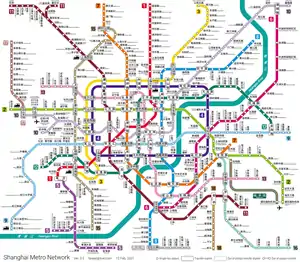
.jpg.webp)

.jpg.webp)
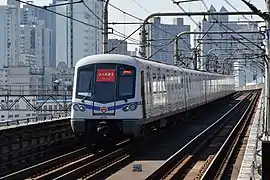

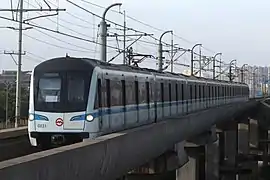
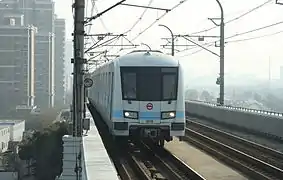
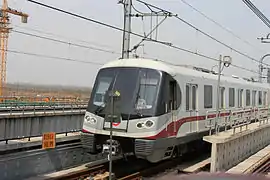

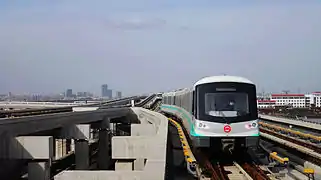
.jpg.webp)


